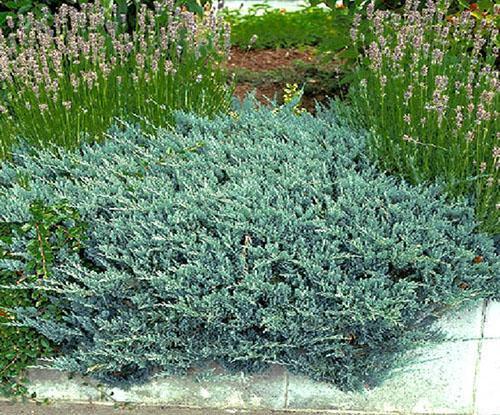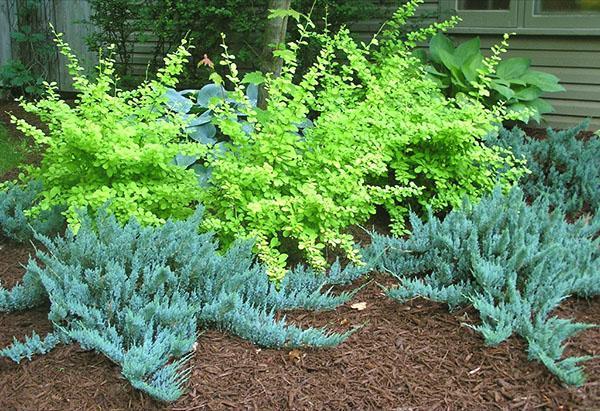Choosing a horizontal Blue Chip juniper to decorate your garden
 Among the ground cover varieties, Blue Chip juniper is considered the best. Its shaggy shoots, with a slightly raised core and ends, spread evenly and densely along the ground, forming a green carpet. The needles are short and dense, needle-shaped and prickly. The needles change color depending on the season: in summer the needles are of a rich silver-blue hue, young bright blue twigs appear in spring, in the fall it is filled with brown and lilac colors, and in winter its tone becomes almost lilac.
Among the ground cover varieties, Blue Chip juniper is considered the best. Its shaggy shoots, with a slightly raised core and ends, spread evenly and densely along the ground, forming a green carpet. The needles are short and dense, needle-shaped and prickly. The needles change color depending on the season: in summer the needles are of a rich silver-blue hue, young bright blue twigs appear in spring, in the fall it is filled with brown and lilac colors, and in winter its tone becomes almost lilac.
Juniper horizontal Blue Chip is an excellent option for rocky compositions, rockeries and rock gardens, it looks harmoniously in combination with other coniferous and deciduous trees and shrubs. Juniper is a natural healer; it effectively purifies and disinfects the surrounding air within a radius of 10 meters.
Description of Juniper Horizontal Blue Chip

Description of Juniper Blue Chip:
- Appearance. It belongs to dwarf creeping evergreen varieties of juniper, differs in its small size and compact shape, raised middle and high decorative characteristics, has small needle-like needles. Seeds are spherical cone berries and black bloom, reaching 5-6 mm in diameter.
- Requirements. He loves light and good soil moisture, is resistant to frost and drought, tolerates urban gas pollution and air pollution, does not tolerate an excess of moisture and excessive soil salinity.
- Where is used. Often planted as a support for rocky slopes and walls, to strengthen slopes and curbs. The ideal solution for landscaping rock gardens and heather gardens, looks good in a container with the need for decorative crown molding.
The beautiful, dense and fragrant horizontal juniper Blue Chip, with long creeping shoots and a bright unusual color, is used by gardeners to create living coniferous carpets.
Juniper Blue Chip - planting
 Young seedlings are planted in planting holes 50-70 cm deep with a sufficient drainage layer in sunny or slightly shaded areas. the shrub prefers nutritious, moderately dry soil, mainly with an alkaline or acidic environment. The culture does not withstand stagnant moisture and soil salinization; regular shallow loosening is required to achieve the best decorative results.
Young seedlings are planted in planting holes 50-70 cm deep with a sufficient drainage layer in sunny or slightly shaded areas. the shrub prefers nutritious, moderately dry soil, mainly with an alkaline or acidic environment. The culture does not withstand stagnant moisture and soil salinization; regular shallow loosening is required to achieve the best decorative results.  The optimal distance between adjacent plants is 1-2 meters. For the winter, the ephedra is sprinkled with peat in a layer of up to 10 cm; during heavy snowfalls, temporary protection is built around it.
The optimal distance between adjacent plants is 1-2 meters. For the winter, the ephedra is sprinkled with peat in a layer of up to 10 cm; during heavy snowfalls, temporary protection is built around it.
Agrotechnical features of Blue Chip juniper are abundant watering after planting, mandatory mulching to retain moisture, and regular sanitary cutting.
Juniper Blue Chip - reproduction and care
 The Blue Chip shrub is propagated by layering. The gardener chooses healthy and high-quality shoots, prepares the soil for rooting - digs up, loosens with peat and sand, fertilizes and moisturizes. With the help of a bracket, the selected branch is fixed on the ground, the layering takes root within six months or a year.
The Blue Chip shrub is propagated by layering. The gardener chooses healthy and high-quality shoots, prepares the soil for rooting - digs up, loosens with peat and sand, fertilizes and moisturizes. With the help of a bracket, the selected branch is fixed on the ground, the layering takes root within six months or a year.
Planting and caring for the Blue Chip juniper includes the following activities:
- Top dressing after planting is carried out three times per season: in spring nitrogen fertilizers, in the summer with phosphorus-containing compounds and in the fall - with mixtures for conifers with potassium. The plant gratefully responds to application around the trunk organic fertilizers.
- Watering regularly, but not excessive. For the best moisture retention near the trunk circles, mulch from chips or sawdust is generously poured.
- Pruning is carried out in the spring - dry and broken shoots are removed, old and frozen branches are cut off.
- Weeding and loosening are carried out as needed, the excess of weeds harms the decorative characteristics of the plant.
- Diseases and pests. Coniferous crops can suffer from root fungus and rot, often infested with ticks and scale insects. For preventive purposes, juniper thickets, in the spring and once a month during the warm season, are treated with fungicides and insecticides.
The Blue Chip juniper is picturesque at any time of the year, with its help, colorful corners are created near stones and near water bodies, they are effectively decorated with flower beds and flower beds. An additional advantage is that the plant creates a microclimate around it that is beneficial for people.
Photo of juniper Blue Chip in landscape design



